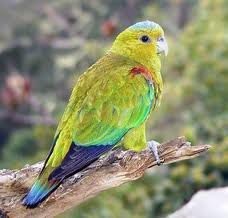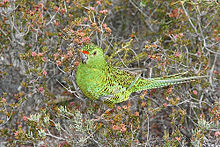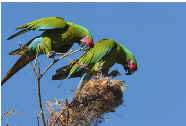
| Amazon Expedition Travel
|
 |
|
|
|

| User Functions
|
|
|
Don't have an account yet? Sign up as a New User
|
|

| Help support this site!
|
|
|
Help support this site... your donations are needed to support research, conservation, and rescue efforts.
|
|

|
 |
| Colombian reserve to double in size, aiding critically endangered parrot |
 |
Tuesday, May 15 2012 @ 07:09 PM UTC
Contributed by: MikeSchindlinger
Views: 35028
|

 The critically endangered Fuertess Parrot and eleven other globally threatened species of birds, mammals, and amphibians will receive greater protections thanks to a joint effort by Fundación ProAves, World Land Trust-US, Robert Giles, Loro Parque Fundación and American Bird Conservancy. The critically endangered Fuertess Parrot and eleven other globally threatened species of birds, mammals, and amphibians will receive greater protections thanks to a joint effort by Fundación ProAves, World Land Trust-US, Robert Giles, Loro Parque Fundación and American Bird Conservancy.
These organizations joined forces to acquire about 356 acres of land to double the size of the existing Giles-Fuertesi Nature Reserve. The reserve is managed by ProAves, ABCs Colombian partner and the leading conservation organization in that country.
With fewer than 250 individuals thought to exist, the beautifully colored Fuertes's Parrot is one of the worlds rarest birds. Also known as the Indigo-winged Parrot, it was thought to be extinct for 90 years, but was rediscovered in 2002 when ProAves biologists, funded by an ABC grant, discovered a small population of about a dozen individuals living in fragmented and unprotected high-Andean cloud forests at the site of this reserve. The Fuertess sole breeding habitat remains a 19-square-mile area.
The Fuertess Parrot is endemic to Colombia and exists only in the wild at two sites where it bizarrely depends on epiphytic mistletoe fruits, said Lina Daza, Executive Director of FundaciónProAves, so with our partners support to secure private lands for its conservation, we have ensured a new and important lease of life to this wonderful parrot and a major step away from the abyss of extinction.
|
|
|
| New Australian Parrot Species Discovered |
 |
Sunday, December 19 2010 @ 12:06 PM UTC
Contributed by: MikeSchindlinger
Views: 35680
|
 A team of Australian researchers has identified a new, critically endangered species of ground parrot in Western Australia.
A team of Australian researchers has identified a new, critically endangered species of ground parrot in Western Australia.
By the BirdChannel.com News Division
Posted: December 15, 2010, 11:00 p.m. PST
 Australian researchers have identified a new, critically endangered species of ground parrot in Western Australia.The team, led by Australian Wildlife Conservancys Dr. Stephen Murphy, used DNA from museum specimens up to 160 years old to reveal that populations of ground parrots in eastern and western Australia are highly distinct from each other and that the western populations should be recognized as a new species, Pezoporus flaviventris. Australian researchers have identified a new, critically endangered species of ground parrot in Western Australia.The team, led by Australian Wildlife Conservancys Dr. Stephen Murphy, used DNA from museum specimens up to 160 years old to reveal that populations of ground parrots in eastern and western Australia are highly distinct from each other and that the western populations should be recognized as a new species, Pezoporus flaviventris.
The discovery has major conservation implications, said Murphy in an Australian Wildlife Conservancy press release. The Western ground parrot has declined rapidly in the last 20 years, there are now only about 110 birds surviving in the wild and most of these are confined to a single national park. It is now one of the worlds rarest birds.
|
|
|
| World's only migratory parrots in peril |
 |
Thursday, May 20 2010 @ 01:52 PM UTC
Contributed by: MikeSchindlinger
Views: 13579
|
 Two Australian parrots migrate annually over Bass Strait a voyage that threatens their survival.
Two Australian parrots migrate annually over Bass Strait a voyage that threatens their survival.
WHEN WE THINK OF animal migration, images come to mind of great herds of caribou moving across the tundra or of the dust rising on Africa's Serengeti under the hooves of thousands of wildebeest. But the true champions of migration are the birds.
Every year hundreds of millions of birds from massive storks and geese down to the tiniest hummingbird take to the wing on a journey into the unknown. The Arctic tern makes an annual pilgrimage from the Arctic Circle to the edge of the Antarctic pack ice and back again. And last year a ruddy turnstone (a dumpy shorebird about half the size of a chicken) was tracked on a 27,000 km round trip from Australia to Siberia and Alaska, at times flying for six days non-stop across the oceans.
This last weekend on World Migratory Bird Day (9 May), people gathered around the globe to celebrate the wonder of bird migration. Few would have had parrots in their thoughts, but here in Australia we have the world's only two long-distance migratory parrots.
|
|
|
| Mexico's Parrot Trade Exposed |
 |
Monday, April 27 2009 @ 12:52 PM UTC
Contributed by: Paul Brennan
Views: 9066
|
 Defenders Magazine
Defenders Magazine
Spring 2009
Mexico's Parrot Trade Exposed
Defenders of Wildlife fights to stop trafficking of wild birds
by Charles Bergman
Arms flailing and menace in her eyes, the woman charges me from behind a pile of cages. I heard her husband say something about giving her a cuchilloa knife.
"No photos!" she yells in Spanish. "Don't take photos! Get out of here!"
I back away slowly.
We are in Xochimilco, a lively, outdoor market in Mexico City, where this woman is running a puesto, or stand for selling animals. She has stacks of animals in cages all around her, like walls of living creatures. In her cages are yellow-cheeked Amazons and orange-fronted parakeetsnative Mexican parrots, caught in the wild. She doesn't want me to photograph them because they are illegal.
Juan Carlos Cantu, director of Defenders of Wildlife's Mexico office, has brought me here, along with Maria Elena Sanchez, president of Teyeliz, a Mexican conservation organization. For over a decade they have been fighting Mexico's illegal parrot trade. No one in the country knows more about it than these twonot the authorities, not even the traders. With support from Defenders of Wildlife, they have recently published the first comprehensive report on the problem, exposing the tricks of this trade. They brought me to Xochimilco to show me its dark and dirty secrets.
"This woman knows what she's doing is illegal," Cantu says. "That's why she's angry. Sellers often get violent."
When Cantu and Sanchez began their research, they already knew the illegal trade was huge. "We knew because we could see them for sale in the markets, like these parrots here," says Cantu. "But no one knew how big. Now we have numbersfor the first time."
According to the study, between 65,000 and 78,500 parrots are illegally trapped in the wild in Mexico every year, and thousands are smuggled across the border into the United States.
|
|
|
| Good News for Critically Endangered Parrot |
 |
Monday, February 23 2009 @ 08:17 PM UTC
Contributed by: Paul Brennan
Views: 6606
|
 The miraculous discovery of a male kakapo (Strigops habroptila), over twenty years after it was last seen has boosted the known world population of this Critically Endangered parrot to 91.
The miraculous discovery of a male kakapo (Strigops habroptila), over twenty years after it was last seen has boosted the known world population of this Critically Endangered parrot to 91.
BirdLife International reports that the flightless, nocturnal bird was recently rediscovered booming (the males unique, resonant mating call) where no kakapos had been detected before.
The bird had not been seen since 1987, when it was one of four males released onto a conservation sanctuary near Stewart Island, New Zealand. As well as giving the potential for introducing extra genetic material into the kakapo breeding programme, the find has raised hopes of discovering more kakapos on this and other islands.
|
|
|
| Illegal Mexican Parrot Trade Targeted by New Ban |
 |
Thursday, October 02 2008 @ 03:39 AM UTC
Contributed by: Paul Brennan
Views: 9021
|

 Illegal Mexican Parrot Trade Targeted by New Ban Illegal Mexican Parrot Trade Targeted by New Ban
Alexis Okeowo in México City
for National Geographic News
October 2, 2008
A new permanent ban on parrot sales in Mexico may protect the country's exotic birds from a thriving illegal wildlife trade, conservationists say.
Mexico considers half of its 22 parrot species endangered, and all but two are protected by federal law.
But between 65,000 and 78,000 parrots and guacamayasa bigger type of parrotare captured illegally every year, and most of these birds die each year before reaching their intended buyers.
The government has been unable to control the clandestine capture and sale of the protected birds, environmentalists say.
The new banan amendment to Mexico's wildlife lawwill eliminate the parrot and guacamaya market completely.
|
|
|
Previous 1 2 3 4 5 6 7 8 9 Next |
 |

| Who's Online
|
|
Guest Users: 2
|
|

| Foster Parrots - Adoption and Conservation
|
|
|
|
|

| Vote
|
|
How many years have you lived with a parrot?
1854 votes | 0 comments
|
|

| Vote
|
|
Where does your parrot's species live? (Cast an additional vote for each bird you live with)
1307 votes | 3 comments
|
|

| Adopt a Parrot
|
 |
|
|
|

| Current Parrot News
|
|
|
Conservation Program Prepares Captive Parrots For Life In The Wild - Texas A&MThese parrots once roamed the American Southwest. Scientists are trying to help them : Short Wave - NPRTHE PARROT KING - National Audubon SocietyDoes parrot farming protect wild species? Wildlife trade researchers review the evidence - The ConversationNew Study Urges Caution Over Growing Trade in Captive-bred parrots - World Animal ProtectionCritically endangered parakeets get a new home on New Zealand island - MongabayVantara reintroduces 41 extinct-in-the-wild Spixâs Macaws in Brazil - Nation ThailandThis unorthodox method is saving baby parrots from extinction - National GeographicWorld Parrot Day: Wild Africa, World Parrot Trust call for stronger protection of parrots in Nigeria - EnviroNews NigeriaFinalists for 2025 Indianapolis Prize helping protect parrots, manatees, jaguars and more - IndyStar'Another record' expected as more captive-bred orange-bellied parrots released - Australian Broadcasting CorporationBreaking Chains, Saving Wings: Wildlife SOS-GSPCA and Forest Department Rescue Parrots from Captivity - Pune Times MirrorCelebrating World Parrot Day: Introducing the IUCN SSC Wild Parrot Specialist Group to Boost Global Parrot Conservation - International Union for Conservation of NatureFIU conservation scientists give trafficked, endangered parrots fighting chance - FIU NewsChinaâs plans to trace wildlife trade risks inflaming trafficking, critics warn - MongabayUC student's parrot conservation work featured in new docuseries - University of CincinnatiFor âextinctâ Spixâs macaw, successful comeback is overshadowed by uncertainty - MongabayCurrent protected areas not enough to save parrots from extinction: Study - MongabaySingaporeâs Wild Bird Trade Raises Troubling Questions About African Grey Parrots - WCS NewsroomRare orange-bellied parrot chick born at Victorian wildlife conservation park - Pulse TasmaniaAfrican grey parrots â cruel conservation concern and pandemic threat discovered in vodou markets - World Animal Protectionillegal trade in parrots punished with strong convictions - International Fund for Animal Welfare | IFAWSaving parrots in the illegal wildlife trade with DNA technology - Earth.comCan We Conserve Endangered Parrots By Keeping Them In Cities? - ForbesEUâs legal loophole feeds gray market for worldâs rarest parrot - MongabayHow To Save Wild Parrots: Some Suggestions From Grey Parrots - ForbesTexas A&M Researchers Apply Free-Flight Training To Parrot Conservation - Texas A&MParrots - Defenders of WildlifeCelebrating World Parrot Day: Costa Rica's Commitment to Conservation and Awareness : - The Tico TimesVideo: Thousands of illegally caught African gray parrots being rehabilitated - MongabayArizonaâs Extirpated, Native Parrots - MeatEaterField Notes: Reinvigorating wild parrot populations with captive birds - MongabayThe KÄkÄpÅ Parrot Returns To New Zealand - Science FridaySome of San Francisco's iconic wild parrots are sick. Meet the people who are saving them. - SFGATETrade in African Grey Parrots for Belief-Based Use: Insights From West Africa's Largest Traditional Medicine Market - FrontiersSaving the blue parrots of South America - BBC EarthUS Fish And Wildlife Provides Funding To Help Conserve The Puerto Rican Parrot - ForbesThere are 14 wild orange-bellied parrots left â this summer is our last chance to save them - The ConversationJuan Carlos Cantú - Defenders of WildlifeSaving flightless parrots from extinction - BBC Wildlife MagazineOrange-bellied parrot shows thereâs more to saving endangered species than captive breeding - The ConversationMore capacity building funds needed for small nonprofit conservation groups (commentary) - MongabayEcho parakeet management programme - ZSLGlobal trade in African grey parrots banned - Phys.org(PDF) Advancing Genetic Methods in the Study of Parrot Biology and Conservation - researchgate.netSingapore's wild bird trade raises troubling questions about African grey parrots - Phys.orgThis parrot was thought to be extinct in the wild â until a farmer spotted one - The Washington PostInternational trade in African grey parrots banned - MongabayAfrican grey parrot has global summit to thank for protected status | Illegal wildlife trade - The GuardianRare Parrots Rebound In New Zealand And Australia - WorldAtlasCritically Endangered Parrot Bounces Back in Huge Conservation Victory - ScienceAlertEndangered Neotropical Parrots Inform In Situ and Ex Situ - researchgate.netConservation Concern for the Deteriorating Geographical Range of the Grey Parrot in Cameroon - Wiley Online LibraryHabitat Preferences of the Grey Parrot in Heterogeneous Vegetation Landscapes and Their Conservation Implications - Wiley Online LibraryFlorida's Wild Parrots Are Being Poached, Sold On the Internet, and It's Perfectly Legal - The Weather ChannelParrots Seized from Congolese Traffickers in April 2022 released to the wild - Modern GhanaHow hobby bird breeders believe they can help save endangered parrots - Australian Broadcasting CorporationHopes of saving orange-bellied parrot hang on foster baby - Australian Broadcasting CorporationForest conservation: Saving the endangered Cape parrotâs natural habitat by planting one tree at a time - Daily MaverickDonât give up on orange-bellied parrots yet, thereâs still hope - The ConversationUWEC releases back into the wild rehabilitated African grey parrots - Nilepost NewsUWEC unveils African Grey Parrot Conservation Center - ChimpReportsWorld Sensation: Return of a Parrot Species Extinct in the Wild â Project Updates - lifePRParrots Seized from Congolese Traffickers Released to the Wild - SoftPower NewsWorld sensation: Return of a parrot species extinct in the wild - lifePREarth Wire -- Global trade in wild African Grey Parrot banned, U.N. meeting rules - ANTARA News119 Grey African Parrots seized from Congolese traffickers released to the wild - standardmedia.co.keUWEC opens Ugandaâs first grey parrot conservation centre - Daily MonitorUganda releases parrots seized from Congolese traffickers - PML Daily
|
|

|
|

|

